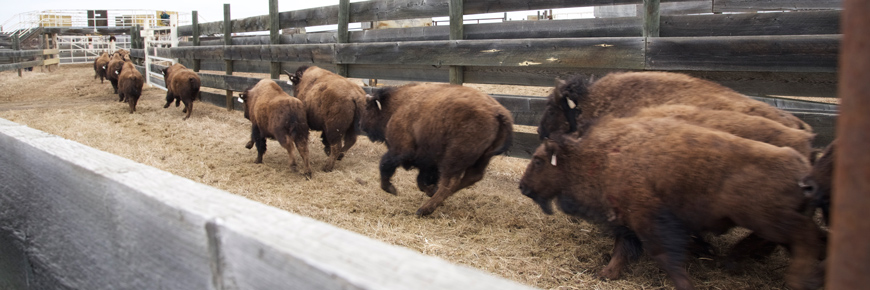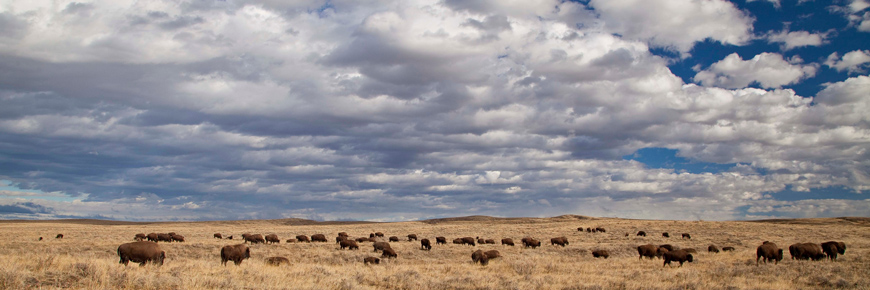
Plains Bison from Elk Island National Park roaming free in Montana on the American Prairie Reserve.
© American Prairie Reserve
Travelling Bison
Elk Island National Park
Have you ever wondered what it would be like to see a herd of thundering bison flowing over the landscape? Elk Island National Park is only 45 minutes away from downtown Edmonton and is the premier Canadian destination to view wild bison wallowing, grazing and galloping in their natural habitat.
Start your own migration and follow Elk Island bison across Canada! Riding Mountain National Park, Grasslands National Park, Waterton Lakes National Park, Rocky Mountain House National Historic Site, Prince Albert National Park, and Banff National Park are all proud to protect bison that stemmed from the Elk Island bison family.
Periodically, bison must be translocated out of the park in order to ensure that the habitat is not over-grazed. This creates an opportunity to provide bison to conservation projects both here in Canada, and internationally. Throughout the park’s history, surplus bison have been provided to other national parks, to conservation projects in Canada and the US, and for auction where they have contributed to Canada’s successful bison ranching industry. Most bison in Canada today are descended from members of the Elk Island herd.
Supporting the relocation of disease-free bison has been an important part of Elk Island National Park’s mission for more than a century. Because of their long history of disease-free status, both the wood and plains bison herds in Elk Island National Park have supplied bison to national and international projects. In total over the past century, Elk Island has translocated nearly 3000 plains and wood bison to conservation sites around the globe. In the past few years, Elk Island has sent bison to support many exciting projects.
Banff National Park

A helicopter used to transport bison is has landed in a mountain meadow.
Parks Canada / Clayton Szafron
In 2017, a small group of bison were sent to Banff’s remote Panther Valley region as a test to see the feasibility of reintegrating bison into the fabric of Banff’s ecosystems, where they have been absent for over a hundred years. This is the first step in the five-year project to inform decisions regarding restoring wild bison in Banff over the long-term.
Bison are often considered to be a plains species but they also called the mountain valleys their home for millennia. Bison were hunted from the Banff area in the 1800s. However, between 1897 and 1997, Banff National Park maintained a herd of bison in a paddock. When the paddock and the bison were removed in 1997 to encourage the free flow of wildlife in the Bow Valley area, it was always the intention to return wild bison to Banff. First Nations people and conservationists have campaigned to return bison ever since.
Blackfeet Indian Nation, Montana, USA

Plains bison calves running down an alleyway in the plains bison handling facility at Elk Island National Park.
© Parks Canada / Scott Mair
The bison, or “iinnii” in the Blackfoot language, is vitally important to First Nations peoples of the plains like the Blackfeet Indian Nation of Montana. There is a wider Indigenous-led movement called the Iinii Initiative to restore bison. The Blackfeet Nation is a signatory of the Buffalo Treaty, which works to restore bison to traditional territory for cultural and conservation reasons. Elk Island sent over 80 calves to the Blackfeet Indian Nation of Montana in the spring of 2016 as a part of the Iinnii Initiative. These bison calves are descendants of bison that once roamed there over 100 years ago.
American Prairie Reserve, Montana, USA

A large herd of plains bison roaming free on the American Prairie Reserve in Montana, USA.
© American Prairie Reserve / Dennis Lingohr
The American Prairie Reserve in Montana is a private initiative to protect one of the most endangered natural ecosystems in North America: native tall-grass and short-grass prairies. The APR is stitching together existing nature preserves and privately held land to create the largest nature reserve in the continental United States. Their ultimate goal is to have 3 million acres under their protection.
Elk Island has contributed to this ambitious project by sharing over two hundred young plains bison over the course of three transfers. The APR is returning native species like plains bison and pronghorn to the area. They hope to restore the natural migration patterns of these species.
Lenskiye Stolby Nature Park, Republic of Sakha, Russia

A specialized trailer carrying wood bison calves is loaded onto a Russian cargo plane.
© Parks Canada
In 2006, 2011, 2013 and 2020 four groups of 30 wood bison were transferred to Lenskiye Stolby Nature Park in the Republic of Sakha, Russia. These transfers were successful and the herd has reproduced and increased. The goal of the nature park is to rebuild an ecosystem like the one that existed in the area before the extinction of steppe bison thousands of years ago. Ecologists hope that the reintroduction of the Steppe Bison’s closest living relative, the Wood Bison, will increase the biodiversity of the region.
Sending wood bison to Russia also supports wood bison conservation. Establishing a genetically viable population in Russia increases the chance of species survival in case populations in North America are struck by wide spread disease or some other calamity.
State of Alaska, USA

The Elk Island wood bison herd was established in 1965 to serve as a source of disease-free wood bison for reintroduction projects. Wood bison from this herd were sent to the state of Alaska in 2008, 2022 and 2024 with further transfers planned for 2026 and 2028.
By working together in this way, Parks Canada and the State of Alaska are ensuring the survival and sustainability of the wood bison, which is currently listed as "threatened" under SARA, the Species at Risk Act.
Translocations to Indigenous communities, Canada

Bison are an icon of Canada’s history. They were an integral part of the lives of Indigenous Peoples, and they still have an important role in the culture of Indigenous Peoples. Restoring bison to the landscape is an opportunity to renew cultural and historical connections.
Over the past decade, the park has worked closely with Indigenous communities that have applied to receive bison to bring the culturally significant animal back to their traditional rangeland, while also facilitating cultural or socio-economic opportunities. Past translocations to Indigenous communities include:
- 89 plains bison to the Blackfeet Nation in Montana (2016)
- 25 wood bison to Saulteaux First Nation, Saskatchewan (2018)
- 30 plains bison to Flying Dust First Nation, Saskatchewan (2019)
- 14 wood bison to Woodland Cree First Nation, Alberta (2020)
- 18 plains bison to Onion Lake Cree Nation, Saskatchewan; 21 plains bison to Poundmaker Cree Nation, Saskatchewan; 40 plains bison to Kainai Nation, Alberta; 25 plains bison to Frog Lake First Nation, Alberta (2021)
- 20 wood bison to Métis Crossing, Alberta; 4 wood bison to Beaver Lake Cree Nation, Alberta (2022).
- 22 plains bison to Mosquito-Grizzly Bear’s Head-Lean Man First Nation, Saskatchewan; 25 plains bison to the Louis Bull Tribe, Alberta; 20 plains bison to Samson Cree Nation, Alberta; 20 plains bison to Saddle Lake Cree Nation, Alberta (2023)
Any nation that is interested in this opportunity is welcome to reach out to the park for more information.
- Date modified :